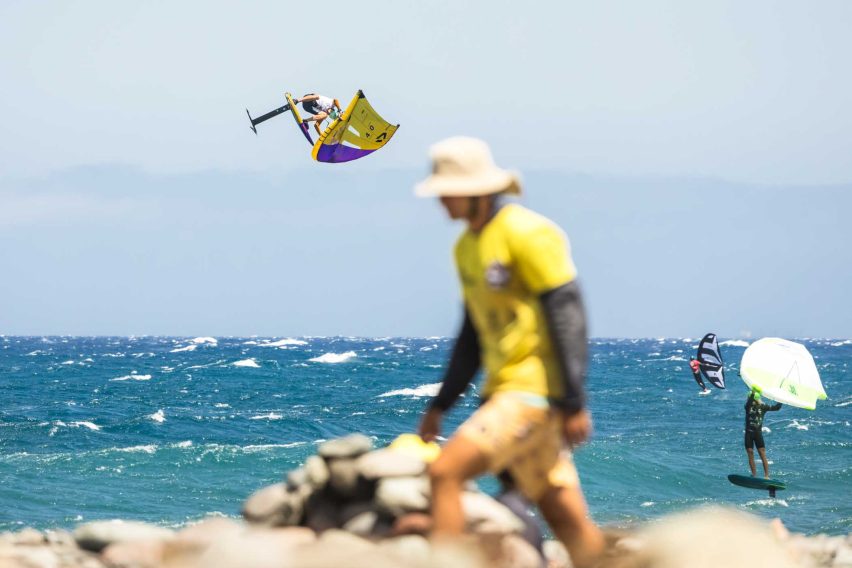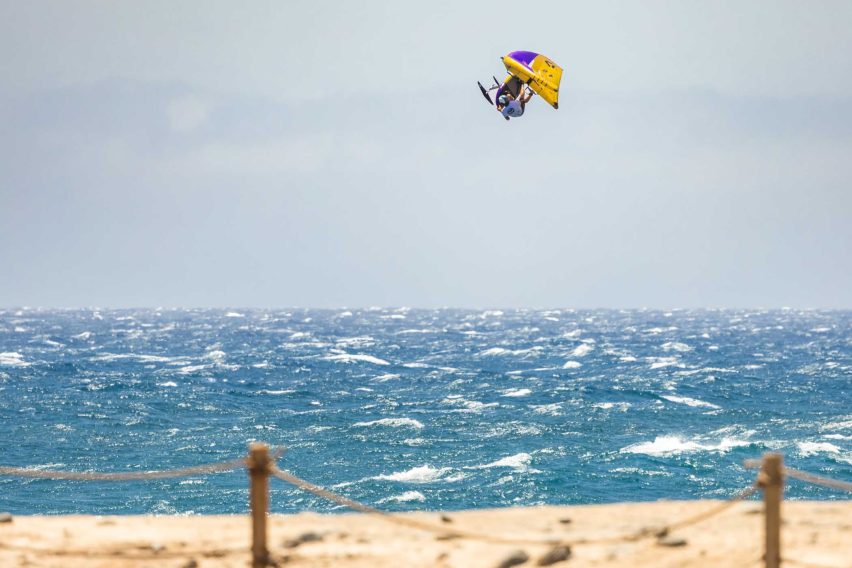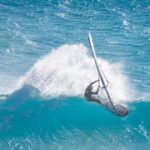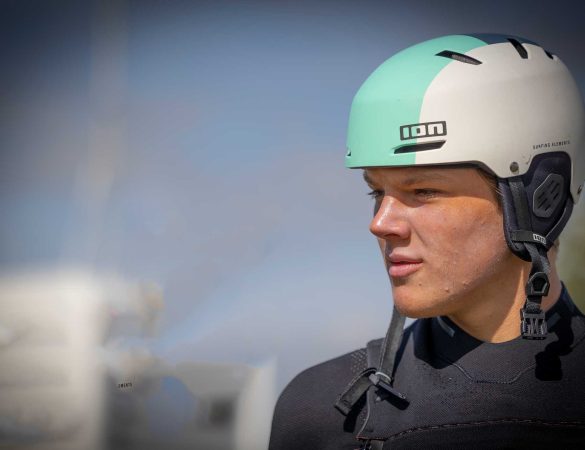The higher the better! Jump high, jump higher, Big Air! We have talked to big air specialist Benjamin May (3rd pl World Cup Gran Canaria 2023) about what it takes to knock out big airs.
TEXT AND PHOTOS DI AXEL REESE
Benji, many wingfoilers want to jump. And then it can be even higher. But at what height is a jump a “big air”?
To be honest, it’s difficult to say. In my opinion, a big air jump counts if it is above your own standard height. To look at this individually for all riders. That means if you jump on average about 2 metres, but then do a 6 or 7 metre high jump, that’s definitely big air. In competition, the jumps are scored well from 10 metres upwards. Depending on whether it’s a straight air or an inverted trick. But in principle, the definition is completely free. Jumps that are as high as possible always look spectacular.

You also became a wingfoiler to jump as high as possible.
Yes, wingfoiling gives me a good adrenalin kick. And, yes, you have to know that I’m a wingfoiler because I don’t have many opportunities or space at home in the south of Germany, far away from the oceans, andonly at a lake, to launch a kite, for example. So wingfoiling is perfect for me at home. That way I can spend enough time in the air.
Last year you were runner-up in the Big Air World Championships in Pozo, Gran Canaria, and in 2024 (you came an equally excellent) fourth place. What does it take to not only jump high, but even higher?
A lot of wind is a basic prerequisite for jumping as high as possible. A steep, powerful wave also helps. It’s usually even better if it comes slightly from the side and doesn’t roll towards you from the front. This extends the distance for the run-up and makes it easier to control.
How high did the top athletes jump?
My highest jump during the competition was just under 11.5 metres with a stalled front flip. Malo Guenole maybe jumped a bit higher and had a few jumps of 12.5 metres. On average, the height of the top jumps was between 10 and 13 metres.
Does the basic rule “the more wind the better, the higher I can fly” apply?
Basically yes, so 35 knots is better than 30 knots and 45 knots is better than 40 knots. But at a certain point there is too much wind involved, 65 knots is too much, then I won’t fly any higher. Theoretically, you could fly even higher. However, as the wind increases, it becomes more and more difficult to control larger wings. That’s why, at wind speeds above 50 knots, you tend to use a 2.5 wing. But it has so little surface area that it no longer carries my 80kg body weight properly. A larger wing then makes little sense as it becomes almost impossible to ride at all.
How much wind did you have at the Big Air World Cup in Pozo?
This year it wasn’t that much, about 28 knots. The reason for this was a two-part event with the kitesurfers and the event committee had decided to give the kitesurfers the only two really strong wind days. The year before there were gusts of up to 50 knots.
Okay, and what size wing did you ride this year at 28 knots?
The 4.0 and 4.5 Unit DLAB, which was quite big.
What wing sizes would you have ridden in freestyle at 28 knots in these conditions?
Yes, in freestyle it would have been 3.0 or 3.5 and for big air about 1.0 to 1.5 square metres. That’s quite a lot! Let me add at this point that I always ride a harness with these well-powered wings, because otherwise my hands would “close up” at some point. On the other hand, I can shake out my arms while riding the trapeze and give my muscles a “little break”, so to speak. That’s good for me when I’m riding such powered wings, even if it doesn’t convince most wingfoilers. But it’s great for big air!
What should the water conditions look like besides the wind?
Yes, I like a wave that doesn’t usually come at me head-on in sideshore conditions, but the wind can be a bit sideshore, like in Pozo, Gran Canaria, so that I can ride the wave down a bit.
On the other hand, if the wave comes at you head-on, the landings will be very hard.
So Pozo is the best place to hit big airs?
Pozo is the best place I know for big air. Apart from that, I also like travelling on the North Sea and the fjord in the north of Denmark, because I can also fly high there in storms.
And in Hanstholm, which is the No.1 jump spot for windsurfers?
Yes, Hanstholm is of course mega with wind directions around WNW. On very windy days, there is a lot of white water in Hanstholm, which creates turbulence on the foil when you go upwind. That makes everything a bit more challenging.
But what happens after crashes? Where do I drift to? In order to jump big air in storm conditions, which are not untypical in Denmark, I prefer to be out on the fjords in real storms from 60 knots. These are great conditions and I can’t be forced out onto the open sea. A lot of people underestimate or don’t realize how well the fjord works for big air. You can hardly see the other side of the shore, it’s so big. No wonder that chest-high waves sometimes come in there.
What riding technique tips do you have for our readers on how to jump higher?
The speed you can build up towards the jump is very important. The greater the speed, the higher you will be able to jump. And you need confidence in yourself to really want to go that fast towards a take-off!
But you don’t just have to have a lot of speed and jump half wind, but shortly before the take-off you go on a slight downwind course and then luff up about 10-15 degrees. These are only short moments, so maybe three to four metres at a time.
Then the take-off!
When taking off, it is important to shift the centre of gravity to the back foot without exception. This generates more pop. It is then advisable to get into as compact a position as possible in order to survive turbulence and gusts. This means pulling your legs to your upper body and, if possible, stretching the board slightly towards the lee. This keeps you compact and prevents you from swinging like with a raley. Otherwise it can happen that the impacts become very hard from about six metres upwards, which not only affects the material but also your own body.
And when you’re in the air?!
When you’re in the air, the process is similar to a normal jump. But there is one crucial difference. Because with a really high jump, a big air, it’s important not to do a raley. If you do, then you have to bring the board forwards again towards the landing, which generates even more propulsion and speed on the space sheet course, which makes the landings so difficult. It’s a challenge for the joints and the board.
What does your riding technique look like instead?
I do a raley forwards, i.e. the back foot moves to the trailing edge of the wing and I pull the front foot in at the same time. It also has a cool style factor!
What does a successful landing look like?
Ideally, you fall backwards into the water. Similar to windsurfing, the impact is lowest when the board doesn’t land flat on the water but dips at a slight angle.
What can go wrong with these high jumps?
If you take it slowly, nothing usually happens. But it’s a natural sport, which means you can only get the best out of your preparation. This includes reading the wind pattern on the surface of the water before you jump. This is because gusty winds can create air pockets, similar to turbulence in an aeroplane. Then it can happen that you simply fall off! Unfortunately, I have already torn a ligament in my foot. However, this is really the exception and only happens if you fall unfavourably. Otherwise, of course, there is always a residual risk, but with the right choice of equipment and sufficient preparation, it can be significantly reduced.
What should the equipment for Big Air look like?
First of all, the board is not insignificant. It can have a few or several litres less volume than your body weight, my basic rule is “about 20 litres less than your body weight” and no more, because then it quickly becomes too heavy.
I also ride the Foil 850 Carve 2.0 from Duotone, which I can push very well at speed. I can also say that I only use this one foil in all conditions, from my local lakes in southern Germany, to my wave sessions in Klitmöller, for freestyle, to the Bir Air World Cup in Gran Canaria. And it works so well that I can achieve top placings at the Big Air World Championships. This year in Pozo, as I said, there were only about 28 knots and I was already flirting with the 650 Carve 2.0, but it would probably have been a bit too small.







